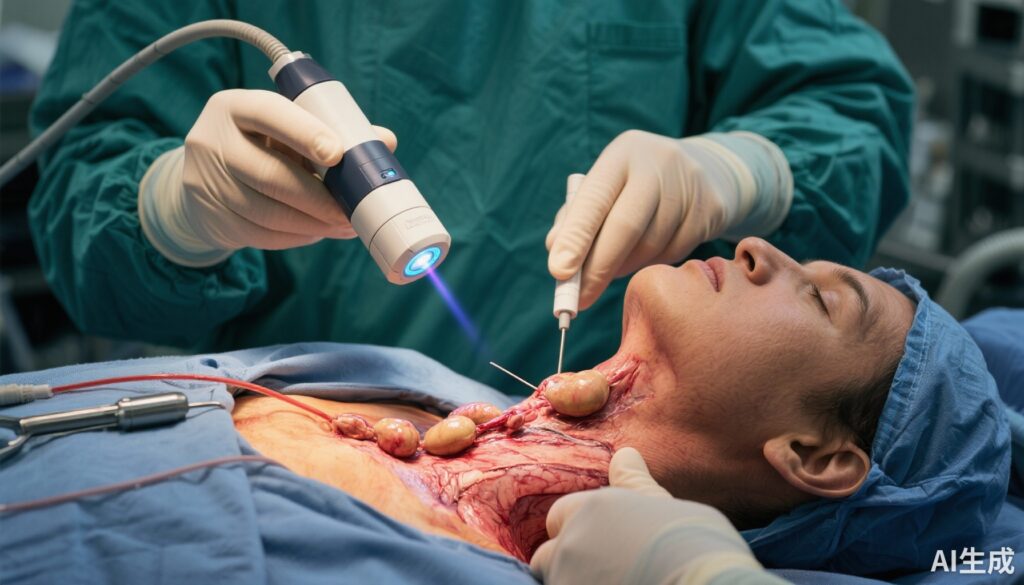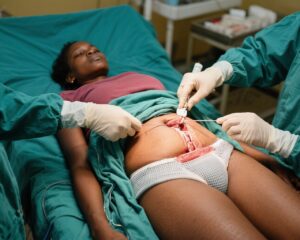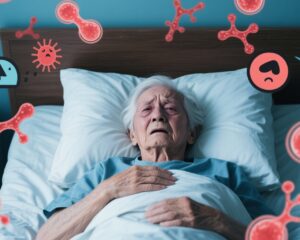Highlight
- Fiber-based near-infrared autofluorescence (NIRAF) significantly increases the number of parathyroid glands identified during thyroidectomy and bilateral parathyroidectomy.
- The increase in gland identification does not significantly affect the rate of transient or long-term hypoparathyroidism.
- NIRAF use does not lengthen surgical duration, indicating its feasibility in routine endocrine neck procedures.
- Results support using NIRAF adjunctively, particularly in bilateral explorations and thyroidectomies, to enhance parathyroid preservation efforts.
Study Background and Disease Burden
The parathyroid glands (PGs), small endocrine organs adjacent to the thyroid, play a crucial role in calcium homeostasis by secreting parathyroid hormone. Inadvertent damage, devascularization, or removal of PGs during thyroidectomy or parathyroidectomy can lead to hypoparathyroidism, a condition characterized by hypocalcemia with symptoms ranging from numbness and cramps to life-threatening cardiac arrhythmias. Transient hypoparathyroidism occurs frequently after thyroid surgery, with persistent hypoparathyroidism being a significant long-term morbidity that compromises quality of life and requires lifelong calcium and vitamin D supplementation. Accurate intraoperative identification and preservation of PGs is therefore paramount to reduce this complication.
Traditional identification of PGs relies on visual inspection and surgeon experience, which can be subjective, especially for less experienced surgeons or in challenging cases such as reoperative surgery and distorted anatomy. Near-infrared autofluorescence (NIRAF) technology leverages the intrinsic fluorescence properties of parathyroid tissue when excited by near-infrared light to provide real-time, objective visualization of PGs during surgery. Recent technological advances have produced fiber-based NIRAF devices, promising handheld and flexible intraoperative use.
Prior nonrandomized or pilot studies suggested that NIRAF aids PG detection, but high-quality evidence regarding its impact on surgical outcomes, especially hypoparathyroidism rates, was lacking. This gap necessitated a rigorously designed multicenter randomized controlled trial to evaluate whether fiber-based NIRAF translates into clinical benefit during thyroidectomy and parathyroidectomy.
Study Design
This multicenter randomized clinical trial was conducted from March 2020 through July 2024 across four academic medical centers in the United States, enrolling 754 patients scheduled for either parathyroidectomy or total/completion thyroidectomy. After two withdrawals, 752 patients were randomized into intervention and control arms.
Surgeons included four senior (>10 years experience) and three junior (<5 years experience) endocrine surgeons to potentially capture differences by surgical expertise. Patients were randomized to either fiber-based NIRAF-assisted surgery or conventional surgery without NIRAF guidance.
The intervention involved intraoperative use of a fiber-based NIRAF device for direct identification of parathyroid glands during surgical dissection. In controls, identification relied solely on conventional visual inspection and palpation.
Primary endpoint was the mean number of PGs identified intraoperatively. Secondary outcomes included rates of transient and long-term hypoparathyroidism, defined by clinical and biochemical parameters, with follow-up to six months postoperatively. Data analysis concluded in January 2025.
Key Findings
Among 712 analyzed patients (94.4% of those randomized), median age was 59 years with a predominance of females (68.4%). The cohort divided into 320 patients undergoing parathyroidectomy (161 with NIRAF, 159 control) and 354 undergoing thyroidectomy (176 with NIRAF, 178 control).
– Parathyroidectomy: For focused (unilateral or limited) procedures, mean PGs identified were similar between NIRAF-assisted and control groups (1.6 [95% CI, 1.4-1.8] vs 1.5 [95% CI, 1.4-1.7]), showing no statistically significant difference.
– Bilateral parathyroid exploration: The NIRAF group identified statistically more PGs (mean 3.5 [95% CI, 3.4-3.7]) than controls (3.2 [95% CI, 3.0-3.4]; P < .001), indicating improved identification accuracy during extensive surgery.
– Thyroidectomy: NIRAF significantly improved identification of PGs (mean 3.3 [95% CI, 3.2-3.4] vs 2.8 [95% CI, 2.7-3.0]; P < .001).
Importantly, despite improved identification, there was no significant difference between groups in the rates of transient hypoparathyroidism post-thyroidectomy (27.8% NIRAF vs 26% control) or long-term hypoparathyroidism at six months (1.7% NIRAF vs 3.4% control).
Additionally, use of NIRAF did not prolong operative time, confirming feasibility in usual surgical workflow.
Expert Commentary
The increased intraoperative parathyroid gland identification with fiber-based NIRAF confirmed by this robust randomized trial signifies a meaningful step toward improving surgical precision in endocrine neck surgery. The lack of significant reduction in hypoparathyroidism rates suggests that identification alone may not be sufficient—other factors such as gland vascular preservation, handling techniques, and individual patient anatomy also critically determine postoperative outcomes.
The improvement noted primarily in bilateral exploration and thyroidectomy underscores NIRAF’s utility in more complex or extensive surgeries where gland localization is challenging. The neutral effect in focused parathyroidectomy might reflect already high identification rates by experienced surgeons without adjunctive technology in limited dissections.
Limitations include potential surgeon bias as blinding was not feasible, the relatively short follow-up to capture permanent hypoparathyroidism, and the exclusion of pediatric or reoperative cases. Future studies might evaluate integration of NIRAF with other intraoperative adjuncts and its impact on surgical learning curves for junior surgeons.
Conclusion
This multicenter randomized clinical trial establishes that fiber-based near-infrared autofluorescence significantly enhances visualization and identification of parathyroid glands during thyroidectomy and bilateral parathyroid explorations without increasing operating time. While improved identification did not translate into statistically significant reductions in hypoparathyroidism rates, the findings support adjunctive use of NIRAF technology as a valuable tool in endocrine surgery aimed at parathyroid preservation. Further research is warranted to optimize strategies that combine gland identification with preservation to reduce hypoparathyroidism and improve patient outcomes.
References
1. Cousart AG, Kiernan CM, Willmon PA, et al. Near-Infrared Autofluorescence for Parathyroid Detection During Endocrine Neck Surgery: A Randomized Clinical Trial. JAMA Surg. 2025;160(9):936-944. doi:10.1001/jamasurg.2025.2233
2. Thomas G, Wang TS, Gauger PG, et al. Techniques for parathyroid gland identification and preservation in thyroid surgery. Surg Oncol Clin N Am. 2019;28(1):109-120.
3. Lang BH, Wong CK, Hung YK, et al. Parathyroid autofluorescence and viability in thyroid surgery: clinical outcomes and technological advances. World J Surg. 2022;46(6):1447-1454.



